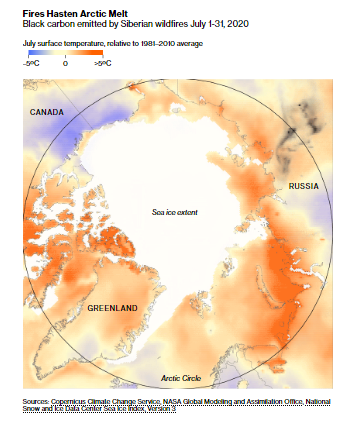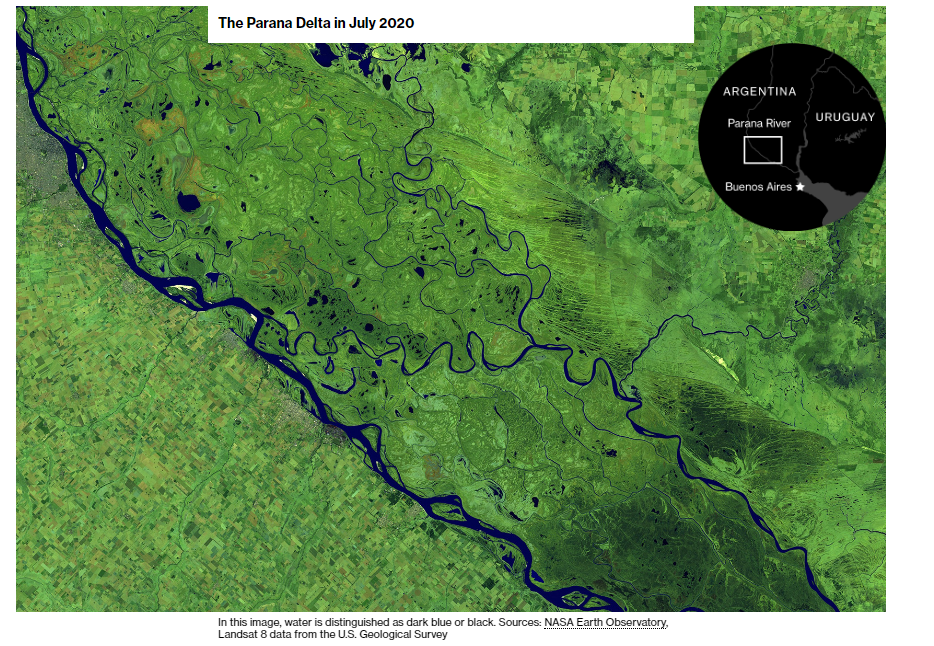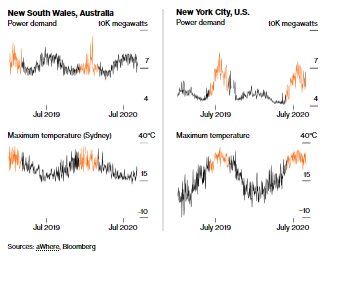Bloomberg: It’s a Race Against Heat, and Humanity Is Losing.

Add this to your already long list of 2020 oddities: Greenhouse gas emissions are projected to experience their steepest drop in modern history while the world remains on track to mark its second-hottest, if not hottest, year.
The two facts demonstrate the relentless pace of climate change and the extreme measures we need to take to slow it down. It’s a perverse race: The later we cut emissions, the faster the planet warms. Right now, it’s one humanity is losing.


While temperatures can vary from one year to another, the trend is clear: Nine of the 10 hottest years on record have happened during the 21st century.
The temperature in Death Valley, Calif., registered 54.4C (129.9F) on Aug. 17, likely the hottest in recorded history

The pandemic lockdowns and the dramatic decline in economic activity that followed will reduce emissions this year by an estimated 8%. But the level of carbon dioxide will continue to climb as long as humanity continues to add it to the atmosphere.
Emissions need to come down to zero by midcentury to keep warming below 1.5C. That will require a 7% decline every year during this decade.

Even 1.5C of warming will render certain parts of the world unrecognizable. If emissions instead rise or stay flat, the picture gets disastrous.
“We’re running an experiment on our planet,” says Zeke Hausfather, the director of climate and energy at the Breakthrough Institute. “If we continue to muddle through, there’s a risk that we might end up with a bad roll of the climate dice.”
Even the Cold Places Are Hot Now
The Arctic is warming faster than the rest of the world. This year, the region is on track for its worst wildfire season in recorded history, toppling a record set in 2019, according to the European Union’s Copernicus Climate Change Service.
Parts of Siberia experienced temperatures 10C above average in May
Not all these wildfires are new. Some were thought to have gone out after temperatures dropped last winter instead continued to smolder under the snow, fueled by methane deposits and fed by peat. Once warm weather returned, last year’s fires reignited.
Arctic wildfires emitted the equivalent of 244 million metric tons of carbon dioxide from January to August, compared with 181 million tons for the whole of 2019, according to Europe’s Copernicus Atmosphere Monitoring Service. Dark-colored particulate matter from wildfires can land on snow and ice, absorbing sunlight that would otherwise reflect off the white surface. Smoke plumes from Siberian fires covered the equivalent of more than a third of Canada.

The Arctic might seem far from human civilization. Yet what happens at the poles affects the rest of us. “We know the climate system is inherently coupled,” says Jens Hesselbjerg, a professor of climate physics at the Niels Bohr Institute in Copenhagen. “Things happening in the tropics and the Arctic have implications everywhere.”
Oceans Take In More Heat
While temperature records on land usually grab most of the headlines, Earth’s most dramatic warming is happening at sea. For decades, oceans have sucked up most of the additional heat trapped by the atmosphere, dampening the effects of climate change.
Ninety-three percent of heat captured by greenhouse gases since the 1970s has been absorbed by oceans
The year’s extreme heat is extraordinary in the absence of El Niño, a cyclical weather phenomenon that causes winds to slow down, making oceans warmer and leading to higher temperatures globally. The warmest year on record so far, 2016, was an El Niño year.
Scientists know the oceans’ ability to capture and store carbon dioxide stopped keeping pace with emissions in the 1990s. A report published in June concluded that the oceans’ sponge-like capacity will keep diminishing, even as the world attempts to cut emissions to zero by 2050, requiring us to cut even more CO2 to keep up.
Warmer waters lead to the formation of more and stronger hurricanes, which can unleash further damage. Hurricane Laura, for instance, was the seventh named storm to hit the U.S. this year, the first time so many have made landfall before the end of August. The system struck as a Category 4 hurricane, the second-highest classification based on wind speed, causing an estimated $20 billion of damage. Forecasters now expect about two dozen named storms each year, about double the previous 30-year average.
*WATCH THE VIDEO HERE
Global Trade Is Suffering in the Heat
Global warming is scrambling well-established rainfall patterns. Some places are struggling with deadly droughts, while others experience overwhelming floods. Food and raw materials supply chains are being disrupted, with trade sometimes grinding to a halt in key locations. As the scale of these impacts grows, it will become harder to adapt.
A 20% reduction in rainfall and a 10% increase in evaporation rates in the Panama Canal area in 2019 have caused water in one of the world’s busiest trading routes to drop below optimal levels. That’s forcing the deepest-hulled ships either to load less cargo or find an alternate route — both costly, disruptive solutions. In January, the Panama Canal Authority announced that every ship crossing the canal will need to pay a new fee of up to 10% of the vessel’s toll, which will rise when water levels decline.
Low water levels caused up to a 15% rise in costs to cross the Panama Canal
Water levels in the Parana River in South America, the main export route for Argentina’s $20 billion crop-exports sector, are at a 50-year low. In April, water levels were just 78 centimeters (31 inches) in Rosario, the country’s grain trading hub; in May, a vessel carrying soy ran aground twice in one week, interrupting navigation for days. This summer, NASA satellites have recorded nearly 28,000 fire alerts, almost four times the annual average, going back to 2012.
Dredging Argentina’s Parana River would cost $3.8 billion, part of a 15-year project to preserve the trade route


We’re Running Out of Places to Hide
Heat waves are becoming more intense and more frequent as the planet warms—and that isn’t just showing up on thermometers. Increased air conditioning usage in developed nations leads to sharp spikes in electricity demand during extreme heat events. That’s been the case this year, for instance, in New South Wales in Australia and in New York.
Summertime Surges
Power demand increases when temperatures climb

Over the past three decades, air conditioners and refrigerators have become ever more energy-efficient; they’ve also become cheaper. At the moment, air conditioners are responsible for about 9% of global electricity demand. Even accounting for efficiency improvements, that figure is expected to rise to 12.7% by 2050, an increase that’s almost equivalent to the European Union’s entire current electricity consumption, according to BloombergNEF.
In oil-rich Saudi Arabia, power plants burn crude oil to meet additional demand in summer, so air pollution rises with heat waves. In July, Riyadh, the capital, registered its poorest air quality for the year as the average high temperature reached 43C.
While crude-burning data aren’t yet available for July, the numbers are expected to be high during a year in which oil prices have tumbled, and many Saudis have been unable to flee to cooler destinations because of the Covid-19 pandemic.
Even during the worst crisis in the tourism industry’s history, Airbnb occupancy rates show that others have left or avoided cities during the hot summer months. Urban areas, already home to more than half the world’s population, tend to be hotter than rural areas because they’re covered in materials such as concrete that absorb heat from sunlight. These so-called urban heat islands will further exacerbate the risks from global warming.
Escaping the city heat and running to cooler destinations during the hottest weeks of the year is a short-term solution available only to a few. Cities will keep growing to house 68% of the world’s population by 2050, according to a United Nations estimate. Some countries are taking drastic steps to try to gird urban areas against climate change, including moving their capitals to more resilient locations. But without immediate and drastic action, the only viable solution will be to adapt.
Those in poor countries who can’t afford air conditioning will bear the brunt disproportionately, according to a recent study from the Climate Impact Lab. By 2100, heat alone could kill as many people as now succumb to heart disease, humanity’s biggest killer.
There’s a Lot We Don’t Know
For all the data we have and the new ways we’ve come up with to interpret it, what we still don’t know is preventing us from acting more decisively to mitigate the effects of climate change.
“Numbers come with uncertainty brackets, and these seem very large for the ordinary person,” says Hesselbjerg, the climate physicist. “It’s sometimes disturbing that we can say more about how things are going to be like 100 years from now than five years ahead.”
How soon will we see ice-free summers in the Arctic? How much of the carbon stored in Siberian permafrost will be released as the ground thaws? How are warming seas and deforestation affecting the capacity of oceans and forests to absorb heat? Sub-Saharan Africa remains a black hole in many climate databases, despite ample evidence that it has not only experienced more heat waves in recent years but will also be more vulnerable to heat waves in the years to come. This means that even the strongest scientific conclusions drawn from that data have blind spots—and that the future could turn out to be much worse than scientists estimate.
“At the end of the day, we need to learn to live with some large, irreducible uncertainties that there’s always going to be a small chance of a truly catastrophic outcome,” Hausfather says. “These uncertainties that we can’t control really reinforce the need to control the one uncertainty we can, which is our own future emissions.”
Editor: Jillian Goodman
Photo editor: Eugene Reznik
With assistance by Jeremy Scott Diamond, Elaine He, Eric Roston, Karoline Kan, Anthony di Paola, Brian K Sullivan and Jonathan Gilbert

BLOOMBERG GREEN




